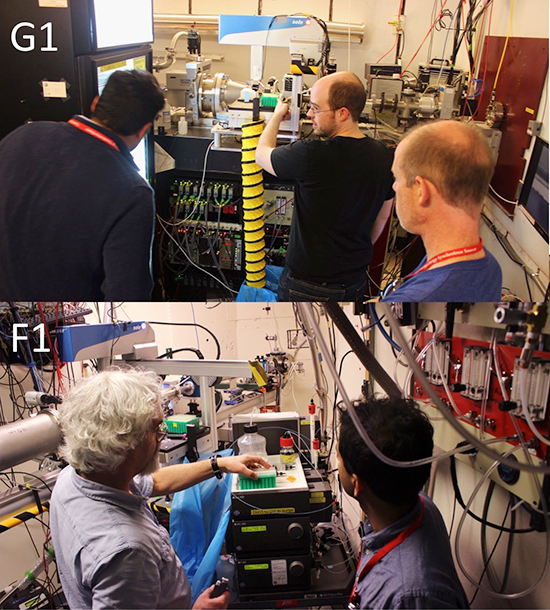X-RAY RUNS: Apply for Beamtime
2017 Nov 1 - Dec 21
2018 Feb 7 - Apr 3
2018 Proposal/BTR deadline: 12/1/17
2018 Apr 11 - Jun 4
2018 Proposal/BTR deadline: 2/1/18
We have now completed our 7th BioSAXS Essentials training course! BioSAXS (Biological Small Angle X-ray Solution Scattering) is a highly popular technique for understanding the structure and behavior of biomolecules in solution, without the need for freezing or crystallization. BioSAXS Essentials is specifically designed as a short, just-the-essentials course for non-specialists wishing to collect and publish BioSAXS data for the first time.
We had 17 on-site students, 5 speakers, and 23 online viewers, for a total of 45 participants. This year, I was very pleased that approximately half of our students were new to synchrotron data collection. Smaller educational institutions were also well represented, and we had corporate and medical center participants as well. The YouTube broadcast of the lectures worked well and allowed distant participants to ask questions of the speakers.
 BioSAXS Essentials 7 participants. Lectures were held atop the new Physical Sciences Building overlooking the Cornell Campus and Cayuga Lake. All but 4 participants were from outside Cornell.
BioSAXS Essentials 7 participants. Lectures were held atop the new Physical Sciences Building overlooking the Cornell Campus and Cayuga Lake. All but 4 participants were from outside Cornell.
As in past years, we configured both G1 and F1 as essentially identical BioSAXS stations to give more students a chance at hands-on experience during the course. Many students were able to bring their own samples to test for the first time. This year, we were fortunate to have two running size exclusion chromatography (SEC) systems attached directly to the beamlines. These “SEC-SAXS” configurations greatly expand the number of samples that can be successfully analyzed by allowing researchers to separate complex mixtures in real time. MacCHESS is unique in the United States in running two such setups simultaneously for SEC-SAXS. Students were introduced to our RAW software, a very easy to use application for collecting and analyzing SAXS and SEC-SAXS data. RAW is available free for Mac, Windows, and Linux, so students were able to install the program on their laptops to take home (https://sourceforge.net/projects/bioxtasraw/). Steve Meisburger (Ando Group, Princeton) recently published a powerful new algorithm for analyzing difficult-to-separate species in SEC-SAXS, the Evolving Factor Analysis (EFA). Jesse Hopkins (MacCHESS) has created the first publicly available implementation of EFA in our RAW software and students got to learn how to use it on their data. Kushol Gupta (UPENN, Perelman School of Medicine) talked about how he used RAW and EFA to solve a difficult separation problem in his own research.
The course started with Richard Gillilan (MacCHESS) giving the introductory lectures on basic SAXS theory and practice. Since proper sample preparation is essential to success in BioSAXS, Kushol Gupta gave a lecture devoted exclusively to that topic. Thomas Grant (HWI) continued the development of SAXS theory and practice with emphasis on shape reconstruction and other more advanced concepts. The three final lectures of the first day were devoted to advanced methods. Steve Meisburger lectured on SEC-SAXS technique, introducing his EFA method. Kushol Gupta discussed how to deal with mixtures, and described how to use contrast variation to locate polynucleotides within protein complexes. Finally, Thomas Grant showed some preliminary results from a very exciting new method to reconstruct actual electron density from SAXS data.
The Wednesday morning session, led by Jesse Hopkins and Steve Meisburger, was devoted to software tutorials. Students installed our RAW software on their laptops and learned how to process data. In addition to basic quality assessment and common processing practice, they learned how to analyse SEC-SAXS data including the novel EFA method.
The tutorial was followed by two days of intensive around-the-clock data collection by students in small groups. Students were able to choose between regular robotic BioSAXS and SEC-SAXS. Both stations were virtually identical in operation, so students trained on F1 find themselves fully competent to operate G1 when they return for normal research beamtime in the future.
Many thanks to all who helped make this training workshop a success!
 BioSAXS Essentials students learn data collection skills from Jesse Hopkins on G1 station (top center). F1 station, normally used for crystallography, was configured as an operationally identical BioSAXS station for the course (Richard Gillilan, bottom left). Both stations supported inline size exclusion chromatography (SEC-SAXS), a popular new technique for separating complex mixtures of biomolecules. During the course, CHESS was the only facility in the nation running two simultaenous SEC-SAXS systems. Also shown: Pedro De La Torre, Michael Durney, and Balasubramnian Harish.
BioSAXS Essentials students learn data collection skills from Jesse Hopkins on G1 station (top center). F1 station, normally used for crystallography, was configured as an operationally identical BioSAXS station for the course (Richard Gillilan, bottom left). Both stations supported inline size exclusion chromatography (SEC-SAXS), a popular new technique for separating complex mixtures of biomolecules. During the course, CHESS was the only facility in the nation running two simultaenous SEC-SAXS systems. Also shown: Pedro De La Torre, Michael Durney, and Balasubramnian Harish.
Submitted by: Richard Gillilan, MacCHESS, Cornell University
06/11/2017
